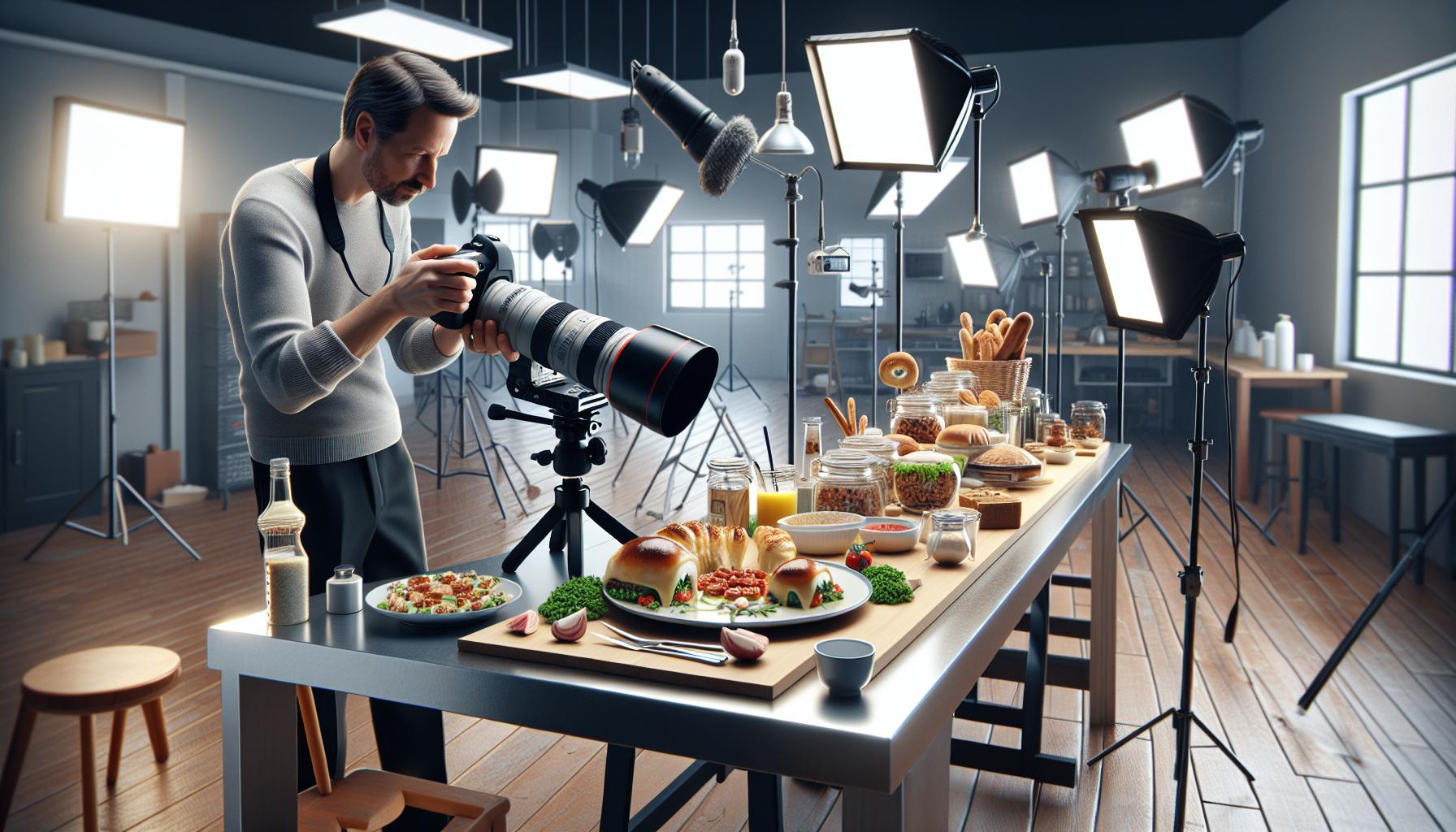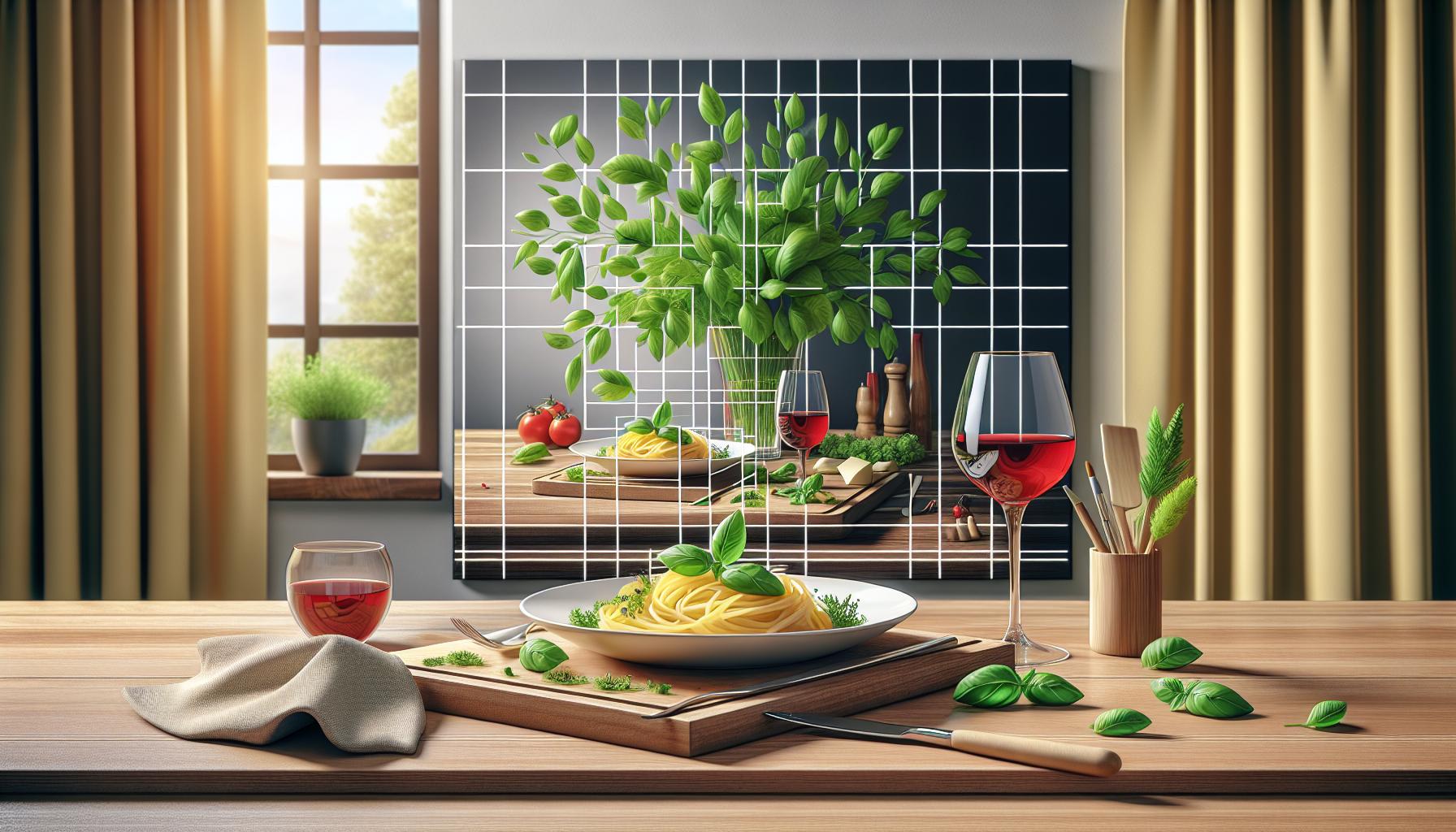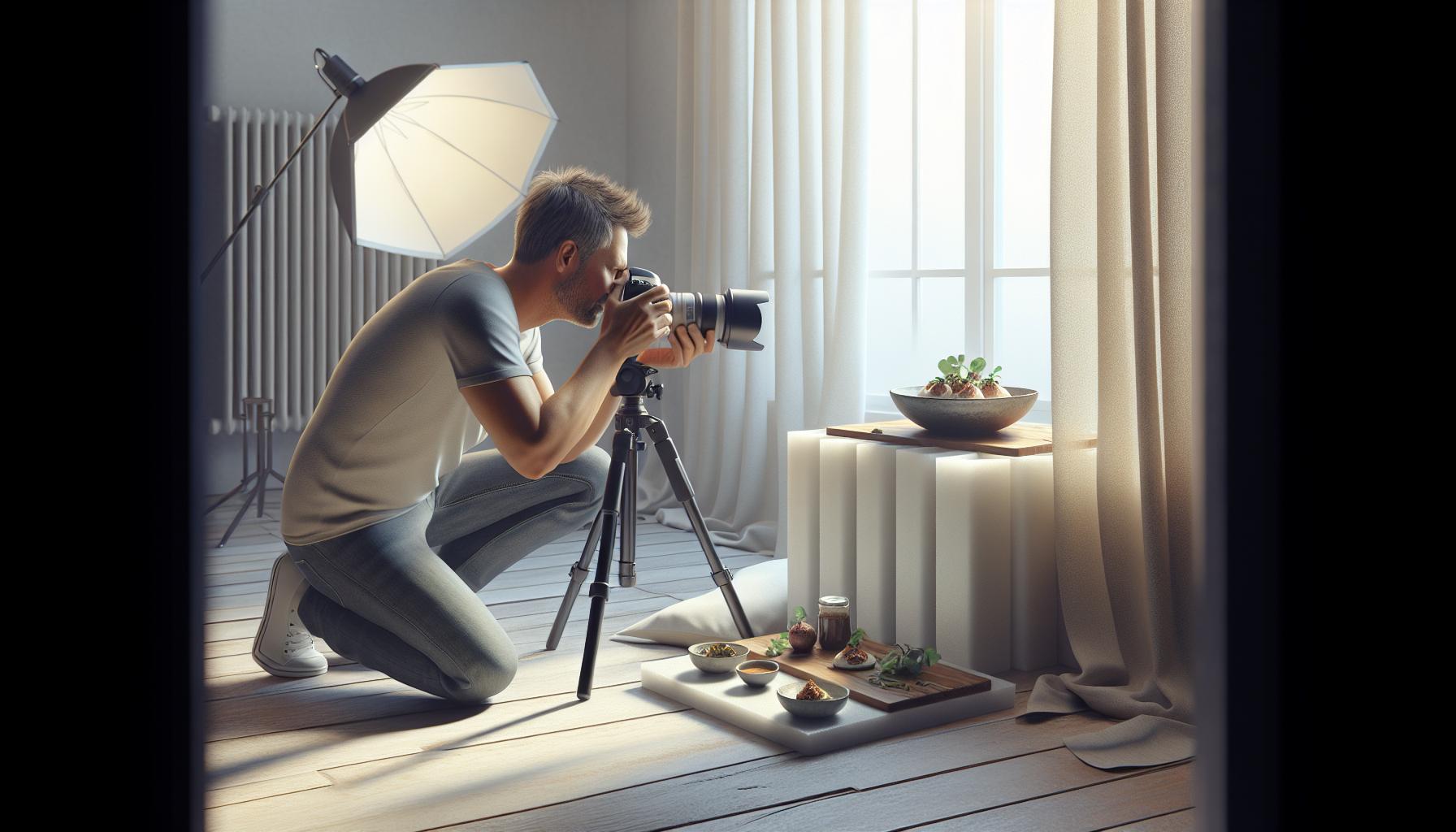Food and beverage photography transforms ordinary meals into mouthwatering masterpieces that make viewers’ stomachs growl with desire. It’s the art of capturing culinary creations in their most appetizing form while telling a visual story that resonates with hungry audiences.
Behind every stunning food photo lies a complex blend of lighting techniques composition skills and styling expertise. From making ice cream look perfectly frozen under hot studio lights to ensuring that steam rises just right from a fresh cup of coffee these photographers are part artist part magician. They’re the unsung heroes who make us impulse-buy desserts at midnight and double-tap those irresistible brunch photos on Instagram.
Food and Beverage Photography
Food and beverage photography captures professional images of culinary items drinks for commercial marketing social media content creation. Professional photographers use specialized techniques to showcase the textures colors aromas of food products beverages through visual storytelling.
This specialized genre encompasses several key areas:
- Commercial Photography: Creating images for restaurants menus cookbooks advertising campaigns
- Editorial Photography: Producing visuals for magazines food blogs culinary publications
- Social Media Content: Developing appetizing photos for Instagram Facebook Pinterest platforms
- Packaging Photography: Capturing product images for labels boxes retail displays
- Menu Photography: Photographing dishes for digital physical restaurant menus
The technical aspects include:
| Element | Purpose |
|---|---|
| Lighting Setup | Highlights texture depth appeal |
| Composition | Creates visual balance interest |
| Color Theory | Enhances food presentation appeal |
| Prop Styling | Adds context atmosphere aesthetics |
| Post-Processing | Refines images for final output |
Food beverage photographers combine these elements to:
- Showcase product features textures flavors
- Create emotional connections with viewers
- Drive consumer purchasing decisions
- Build brand recognition awareness
- Document culinary creations recipes
Modern food photography extends beyond traditional commercial applications incorporating lifestyle elements storytelling techniques to create compelling visual narratives that resonate with target audiences on various platforms.
Essential Photography Equipment

Professional food and beverage photography demands specific equipment to capture appetizing images with precise details textures edges colors. The right combination of tools enables photographers to achieve stunning visual results that meet commercial standards.
Camera and Lens Selection
A full-frame DSLR or mirrorless camera delivers optimal image quality for food photography with features like high ISO performance sensor resolution advanced autofocus capabilities. The Canon EOS R5 Sony A7R IV Nikon Z7 II stand out as top camera choices for their superior detail rendering dynamic range color accuracy. Prime lenses between 50mm-100mm focal lengths create ideal food compositions while macro lenses like the Canon 100mm f/2.8L IS USM excel at capturing intricate details textures. Tilt-shift lenses provide perspective control depth of field adjustments particularly useful for tabletop setups product shots.
- Continuous LED panels: Godox SL-60W Aputure 120d II provide consistent daylight-balanced illumination
- Softboxes diffusers: 2×3 ft 4×6 ft sizes create soft natural-looking light
- Strip lights: Narrow modifiers for rim lighting accent effects
- Light stands C-stands: Heavy-duty support systems for precise positioning
- Reflectors flags: 5-in-1 reflector sets white silver gold surfaces for fill light control
- Color gels: CTB CTO sets for temperature adjustments creative effects
Mastering Composition Techniques

Composition techniques transform ordinary food photos into visually striking images that capture attention and create visual interest. These fundamental principles guide photographers in arranging elements within the frame to achieve maximum impact.
Rule of Thirds
The rule of thirds divides an image into nine equal segments using two horizontal and two vertical lines. Placing key food elements along these lines or at their intersections creates dynamic compositions that draw viewers’ eyes naturally through the frame. A plate of pasta positioned at the lower right intersection balanced by garnishes at the upper left adds visual tension and movement. This technique works effectively for various setups:
- Main dishes centered on intersection points
- Drinks aligned with vertical grid lines
- Garnishes placed strategically along horizontal lines
- Negative space distributed across unused grid sections
- Supporting elements following natural eye movement patterns
- Stacking ingredients at varying heights
- Positioning larger items behind smaller ones
- Using selective focus to separate layers
- Adding textural elements at different distances
- Incorporating complementary props at strategic depths
- Arranging items to guide viewers’ attention inward
Lighting Strategies for Food Photography

Lighting techniques establish the mood and appetite appeal in food photography. The right illumination enhances textures, colors and visual appeal of culinary subjects.
Natural Light Setup
Natural light creates soft, appealing shadows that highlight food textures effectively. A large window serves as the primary light source, positioned at a 45-degree angle to the subject. Diffused sunlight through sheer curtains eliminates harsh shadows and reduces glare on reflective surfaces. A white foam board reflects light back onto the shadow side, balancing the exposure across the dish. Shooting during early morning or late afternoon provides optimal lighting conditions with warm, directional rays. A light tent near the window diffuses harsh midday sunlight, maintaining consistent illumination throughout extended shoots.
Artificial Light Techniques
Professional food photographers utilize strobe lights or continuous LED panels for controlled illumination. A main light mimics window light when positioned at 45 degrees, while strip boxes create graduated highlights on glassware. LED panels with adjustable color temperature match ambient lighting conditions from 3200K to 5500K. Umbrella diffusers soften artificial light sources, creating natural-looking highlights on food surfaces. Multiple small LED lights allow precise control over highlight placement on specific ingredients or garnishes. Gels modify light temperature to enhance food colors, making ingredients appear fresh and appetizing.
Food Styling Tips and Tricks
Food styling transforms ordinary dishes into photogenic masterpieces through strategic arrangement and attention to detail. Professional food stylists employ specific techniques to enhance the visual appeal of dishes while maintaining an authentic appearance.
Plating and Presentation
Food styling begins with selecting the right plate size that complements the portion. White plates create a clean canvas for colorful dishes while textured plates add depth to monochromatic foods. Strategic placement of ingredients creates height differences drawing attention to key elements. Garnishes add pops of color through fresh herbs microgreens edible flowers. Negative space around the dish enhances visual impact allowing the food to stand out. Sauce drizzles dots swirls create artistic patterns that guide the viewer’s eye across the composition.
Working With Props
Props enhance storytelling elements in food photography by creating context atmosphere. Fresh ingredients cutting boards vintage utensils add authenticity to the scene. Linens napkins tablecloths introduce texture color without overwhelming the main subject. Background elements like wooden surfaces marble countertops establish mood setting. Seasonal items flowers produce reinforce timing freshness. Scale consideration ensures props complement rather than compete with the food creating balanced compositions that maintain focus on the culinary subject. Careful prop selection reflects brand identity style while avoiding distracting elements that could detract from the featured dish.
Post-Processing Best Practices
Post-processing transforms raw food photography into polished, professional images through careful editing techniques. These digital enhancements elevate the visual appeal while maintaining authenticity.
Color Correction
Color correction establishes appetizing food tones through precise adjustments in white balance temperature values between 5000K-6500K. Professional editors adjust vibrance settings to enhance food colors without oversaturation, targeting specific hues like reds in tomatoes or greens in vegetables. Advanced color grading techniques include split-toning highlights at +10-15 warmth to create golden undertones in baked goods or adjusting HSL sliders to fine-tune individual color channels. The process maintains natural food appearances while optimizing visual appeal across different display devices.
Enhancing Food Textures
Digital texture enhancement brings out intricate food details through targeted clarity adjustments between +15-30 points. Editors utilize selective sharpening on key areas like bread crusts or meat fibers while maintaining soft bokeh in background elements. Texture tools emphasize surface characteristics by adjusting structure values between 15-25%, revealing subtle details in pasta strands or pastry layers. Advanced techniques include micro-contrast adjustments using curves to define edges without creating artificial appearances. Local adjustment brushes target specific areas to enhance dewdrops on fruits or crystalline patterns in ice.
Commercial Food Photography
Commercial food photography transforms products into compelling visual assets for advertising campaigns, packaging materials, and marketing collateral. Professional photographers collaborate with brands, restaurants, and food companies to create images that drive sales and enhance brand recognition.
Working With Clients
Food photographers establish clear communication channels with clients through detailed creative briefs outlining project objectives, target audience, and brand guidelines. Understanding the client’s vision involves reviewing reference images, discussing styling preferences, and determining specific technical requirements for image delivery. Photographers maintain regular updates throughout production, sharing test shots and incorporating feedback to ensure the final images align with client expectations. Setting realistic timelines, pricing structures, and usage rights upfront creates transparent business relationships that lead to repeat collaborations.
Building Your Portfolio
A professional food photography portfolio showcases diverse technical skills through a curated selection of 15-20 high-quality images. Photographers include various lighting styles, composition techniques, and food categories to demonstrate versatility. The portfolio features commercial projects for recognized brands, editorial work for publications, and personal projects that highlight creative vision. Online platforms like Behance, Instagram, and dedicated photography websites display portfolios effectively. Regular updates with fresh content keep portfolios current and reflect evolving photography skills. Strategic organization by project type, cuisine style, or client category helps potential clients navigate the portfolio efficiently.
Essential Art Form That Combines Technical Expertise With Creative Vision
Food and beverage photography has evolved into an essential art form that combines technical expertise with creative vision. Today’s photographers need both artistic talent and technical knowledge to create images that captivate audiences and drive business results.
Success in this field requires mastering lighting composition and styling while staying current with industry trends and technological advances. Whether pursuing commercial work or building a social media presence photographers who invest in quality equipment develop their skills and maintain high professional standards will find countless opportunities in this dynamic and rewarding field.
The future of food photography continues to evolve as new technologies and platforms emerge making it an exciting time to be part of this creative industry.

